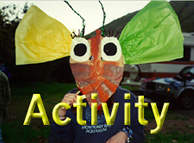TEACHER TRAINING MODULE
TEACHING
CRITICAL THINKING
Teaching
your students with principles and techniques that foster critical
thinking will create an atmosphere of excitement about learning
in the classroom. With this approach, the emphasis in the classroom
becomes one of fostering a deep connection with the course material
as well as with the world around us. It is a powerful way to teach
because it validates the native intelligence that we all possess.
Many
students will enter your classroom
with many preconceived negative notions that could interfere with
their learning. These myths of learning must be acknowledged and
your lesson plans must be crafted with activities that will replace
these notions with positive impressions of the learning process
that could last a lifetime.
 See this page in a PDF
PRESENTATION See this page in a PDF
PRESENTATION
 (Early
20th Century woodcut (from NASA's Astronomy
Picture of the Day) (Early
20th Century woodcut (from NASA's Astronomy
Picture of the Day)
MYTHS
OF LEARNING
Let's
go through each one of these to discuss why you must overcome
these obstacles
 Myth
#1: learning is boring Myth
#1: learning is boring
Showing
students that learning is exciting, fun, and never-ending will establish
them as lifelong learners.
Myth
#2: learning takes place only in a classroom
This
is an important myth to dispell, or else your students will not
associate learning with a lifelong process. Field experiences and
carefully constructed assignments will contribute to dispelling
this myth.
Myth
#3: teaching must be systematic, logical and planned in order to
be effective
Teaching
should work like the human mind and be more dynamic, spontanious,
and relevent. Pursuing tangents and taking advantage of unexpected
interests in students and exploring unplanned current events are
vital. You don't always have to start at the beginning!
Myth
#4: to learn you must put yourself under a teacher
The
student must be the center of their learning experience. They must
be empowered to control their learning experience by being taught
to question the world around them, how to research any problem,
and how to work towards a solution to any issue.
Myth
#5: we must be passive and receptive in order to learn
We
actually learn the worst when our bodies are stiff, ridgid, and
tired from sitting for hours. Learning is a dynamic process. It
begins with questions, continues with observations and data gathering,
and then culminates with exploring other points of views and potential
answers. The more active we are, the more engaged we are in the
process, the more we will learn.
Myth
#6: learning must be thorough or it's not worth doing
Often
a teacher or student won't begin a topic because "there isn't
enough time to cover it." This is actually rarely true. It
is always possible to create a series of questions about a subject
and craft exercises and activities to explore it. The goal of teaching
is not to answer all your students questions. Rather, it is to give
students the intellectual and physical tools to answer any question
for the rest of their lives.
FEARS
OF LEARNING
Some
of your students will also have a number of fears associated with
learning that must also be acknowledged if your teaching is to be
effective.
- I
won't understand what I am learning
- I
am not a (math, science, etc.) kind of person
- I
don't know how to learn this
- I
won't remember what I am learning
- I
feel ashamed when I don't know something
 THE
CONCEPT OF CRITICAL THINKING THE
CONCEPT OF CRITICAL THINKING
Transforming
lessons into ones that have less of a focus on facts and figures and
more emphasis on building a conceptual framework for your students'
learning is surprisingly straightforward. It starts with a willingness
to cast off your own myths and fears of learning and a desire to try
something new. Studies clearly show that students prepared in this
way perform just as well if not better on standardized tests as well
as being much better prepared for future studies.
Most
teachers find the process quite familiar once they begin.
FUNDAMENTAL
PRINCIPLES
Teaching
critical thinking means that students must be taught:
-
that there is something to figure out.
-
to notice their world and become skilled observers and listeners.
- to
ask questions and wonder about the world.
- To
challenge assumptions and biases.
- To
consider multiple points of view.
- To
take responsibility for their actions.
- To
think at a deep rather than a superficial level and not oversimplify
or generalize.
- To
critically access their own work.
- To
tolerate uncertainty.
To
accomplish this, teachers must:
- cover
less so that students learn more.
Learning cannot be measured by the quantity of information presented.
After an exam, students taught in this way will often say "whew,
I'm glad I don't have to know that anymore."
- create
an environment for learning where students make discoveries for
themselves.
- become
facilitators rather than lecturers, gently leading students towards
discovery.
- remodel
their lesson plans, turning their lectures into interactive, creative
learning experiences.
The
activities in these modules have been constructed to foster critical
thinking in you and in your students.
The
Process of Remodeling Your Lesson Plans
- Start
with one of your lesson plans.
- Critique
this plan for ways critical thinking could be fostered.
- Create
the two or three fundamental and powerful objectives you would like
to see accomplished by this lesson plan.
- Select
critical thinking strategies derived from critical thinking principles.
- Include
Socratic questioning and role playing features.
- Create
meaningful activities and assignments that will encourage the student
to discover the answers to the questions.
- Develop
a meaningful assessment strategy.
 Critical
Thinking Strategies Critical
Thinking Strategies
 Remodel
one of your lesson plans to include principles of critical thinking. Remodel
one of your lesson plans to include principles of critical thinking. |
|